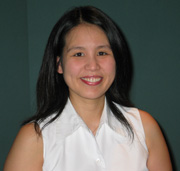She sits in a seductive pose on the barstool, wearing knee-length, black, leather boots and a short skirt. Sitting next to her is a girl, in blue-jean overalls with braided pigtails and a broad smile.
The photo of the two cousins is unremarkable.
The story behind it is disturbing.
 |
Nobuko Oyabu |
“The children in the photograph are both 5-years-old,” Oyabu tells the audience gathered in the Eppley Science Hall Amphitheater for the last Olson Center Brown Bag program of the season.
“But it is clear to see which one had her innocence taken from her,” she said. “The child on the barstool, now the woman holding the photograph, was repeatedly sexually abused by her father.”
Oyabu started the project in January 2001, as part of her own healing process after having been raped two years earlier by a former neighbor in the Chicago apartment complex where she lived.
The reality of the trauma incurred upon survivors of rape and sexual abuse became even more evident when Oyabu took part in a T-shirt therapy project and saw the humiliation and rage reflected in the artwork of other survivors.
“All I saw on the T-shirts was shame and anger,” Oyabu said. “But I didn’t feel ashamed, I didn’t do anything wrong. So I signed my name to the T-shirt I made. I wanted people to know that I am someone who has feelings and a name.”
Soon after, Oyabu began photographing her friends who told her about their rape and sexual abuse experience.
She hoped to publish the photographs in the daily newspaper where she was working.
“I am a photographer and this is the only way I found to show the faces of rape and sexual assault,” Oyabu said.
Putting real faces on the issue is vital in breaking through the stereotypes and stigma attached to the victims. “There are so many different types of sexual violence I didn’t know until I met these survivors,” Oyabu said. “And each person has a name, has feelings and is not just a statistic.”
Since she began her project, Oyabu has traveled around the country, exhibiting her black and white portraits of women and men who have survived sexual violence.
Oyabu’s portraits have been used as an educational resource for sensitivity training for those who first respond to crime scenes and those who treat victims.
“I hope that you find something in this presentation that makes you a little more sensitive to victims of rape and sexual abuse,” Oyabu told the healthcare providers in the audience.
“Because you are one of the very first people to respond to these people when they come to the emergency room.”
Note: The monthly brown bag lectures are videotaped and placed in the video library on the Olson Center for Women’s Health Web site (www.unmc.edu/olson), where they are available for two years.